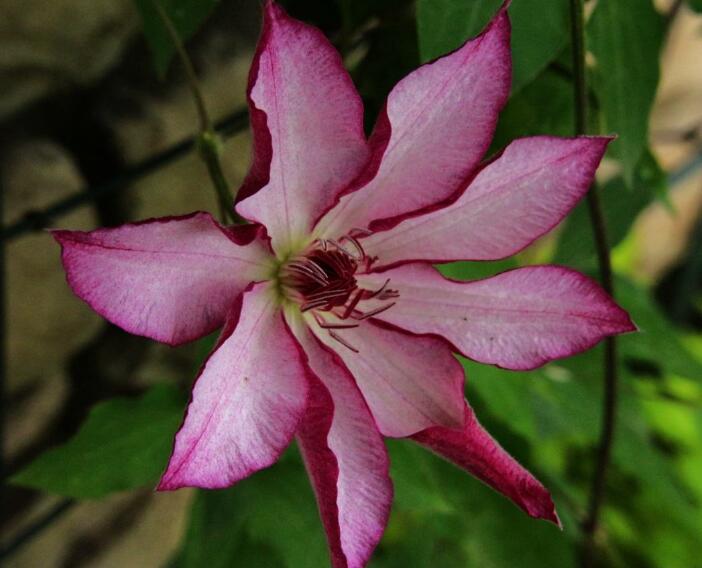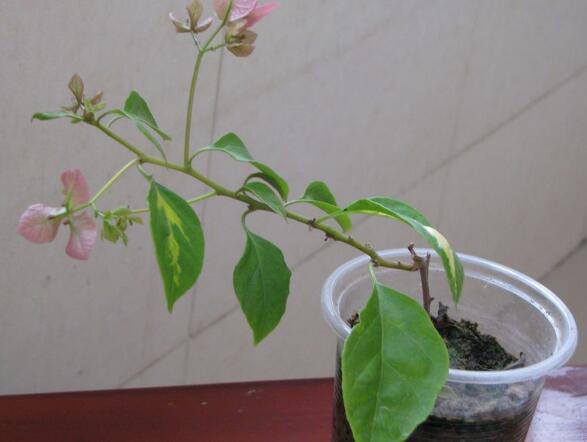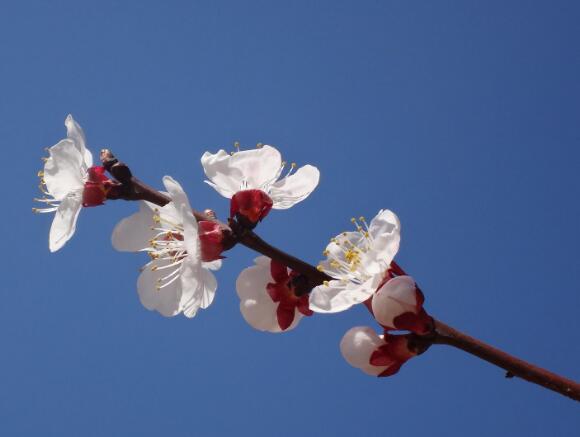How to propagate Clematis, the method of propagation / sowing / cutting / ramet of Clematis
Clematis is a common plant in people's life, because of its gorgeous appearance, it is loved by many people. Because there are more people like it, how to breed clematis has become an issue of concern to people. What are the breeding methods of clematis? Next, the editor will take you to learn about it.

How to propagate Clematis / 5 breeding methods
1. Cuttage propagation
The effect of cutting propagation on the cultivation of hybrid clematis is generally carried out in autumn. We can choose semi-mature branches, the medium we can choose perlite and vermiculite, cutting depth is generally on the node of the branch bud just exposed to the soil surface.
two。 Sowing and reproduction
Among the breeding methods of clematis, sowing and reproduction is the most common one. This method is generally carried out in spring. After sowing, you can cover the seeds with soil around 2cm. Remember to water them in time after sowing, and then leave them for 3-4 weeks to germinate.
3. Striping propagation
Striping propagation is generally best carried out around March every year, which is that we can choose the mature branches of the previous year to carry out. This method will take root relatively slowly, usually in a year or so.
4. Grafting propagation
When propagating the hybrid varieties of clematis, we can choose this method of grafting propagation. Generally, the single-node scion is grafted on the rootstock by split grafting, with 2 buds on the node and 5-10cm under the node, which is easier to survive in an airtight environment.
5. Ramet propagation
Ramet propagation is a kind of clematis which is rarely used in clematis breeding methods. It is generally used in clematis which have grown for about 3-4 years. The method is the same as general ramet propagation.
The method of Cuttage Propagation of Clematis (example Operation procedure)
Clematis has gradually become popular in the past two years. Indeed, its flowers are so beautiful that they deserve the laudatory name of "Liana Flower Queen".
At present, the propagation method of clematis is mainly by cutting. However, because of its long internodes, there are not many cuttings for a clematis to cut. Therefore, the survival rate is particularly important for clematis cuttings! Because there are not many materials.
Cutting method of Clematis clematis
The propagation, cultivation and propagation methods of clematis: sowing, striping, grafting, split or cutting propagation.
1. Selection of cuttings
This step is the most critical point for Clematis cuttings to survive. First of all, of course, there should be healthy and healthy branches with at least one node. The second is to choose semi-Lignification, this year's new article, should not be too young nor too old. Finally, the incision should be flat, the knife should be sharp, do not squeeze the incision.
2. Selection of matrix.
Clematis generally prefer fertile substrates with good drainage. You can choose a matrix in which peat and perlite are mixed at 3:1 or 2:1. Water thoroughly before cutting.
3. Before cutting
Cuttings can be soaked in rooting for half an hour. Punch the hole with a stick, put the insert in, and press it with your hands. Insert 2-3 cm, or leave the node on it. After plugging in, pour water thoroughly.
4. Avoid the sun
Note that it should not be placed in strong light, but there should be astigmatism and good ventilation. In addition, to maintain humidity, the temperature had better be controlled at 20 to 30 ℃. You can use plastic bags to moisturize. Generally 15 days or so, the incision will expand, begin to take root signs, the upper bud will also pull out long leaves, a month or so can take root.
Introduction of clematis propagation methods-Clematis clematis propagation mainly depends on clematis propagation methods such as cuttings, cuttings and ramets, and hybridization and sowing are mostly used for variety selection. In recent years, due to the maturity of tissue culture technology, tissue culture clematis has also become a way of large-scale propagation, and new varieties can be selected by artificial induction in the process of tissue culture. For family planting, if you want to propagate a small amount of clematis seedlings and share them with friends, you will use cuttings, striping and ramets. 1. Clematis crimping is a simple, natural and asexual method of reproduction. Late spring to early summer, or late summer to early autumn is a good time to try clematis. Press the branch directly to the ground, dig a small trench of 7.5cm next to the plant, and fix the stem in the trench. The length of the trench depends on the number of branches that need to be propagated. Put some organic soil, or peat, in the ditch and mix it with the surrounding soil. Add a few handfuls of gardening gravel or sharp sand and mix it slowly as well. Choose a strong, elastic branch that bends easily to the soil. Trim the leaves. Take two or three blade joints (nodes) and put them in the trench. Using a sharp knife, 1.25CM at and below the blade node, draw a small, oblique cut, cut the node, but not cut. Use the root promotion powder to apply to the cutting place of the node. Treat the other one or two nodes in the same way, then fix the stem in the trench and cover the surface with soil. Insert a pole into the soil to support the growing stem tip and secure it to the pole at the top 45cm. Water the striping trench and, if necessary, also water the mother plant. Finally, in order to prevent some unpopular things, such as cats and dogs, from digging a trench and covering it with some slender hat-shaped barbed wire, or something hard. Often water the striping trench to keep the lower stem moist. If in the long dry season, the mother plant should also be watered. After 12 months, the striping can be successful. At that time, cut off the stem connecting to the mother plant, dig out the new plant carefully, and transplant it into a planting bowl filled with soil. Clematis can also be pressed in seedling bowls filled with soil. The reason for pressing with a seedling bowl is that the roots of the new plant can grow directly here, and finally removed from the soil without harming the roots. New plants can also be easily transplanted into a larger pot container. You can start with a 10cm-sized nursery bowl. Fill the soil and bury it near the mother plant. The leaf node is fixed in the seedling bowl. Always check the seedling bowl to keep the soil moist. In order to survive two or three new plants, two or three seedling bowls are used and the nodes are fixed separately in the corresponding seedling bowl. The new plants obtained by striping are the same as the cuttings (see below) and are transplanted into the seedling bowl before planting. 2. Clematis can be propagated by cutting with soft woody stems or moderately mature branches. The soft woody stem refers to the youngest and darkest part of the stem. Cuttings are generally selected from mid-spring to early summer, and 4-Mel is needed to take root for 8 weeks. The cuttings of moderately mature branches use partially mature lignified branches. It can be carried out from mid-summer to early autumn, and it takes 8 Mel to take root in 12 weeks. The way of cutting propagation is generally the node cutting, that is, the basic cutting is carried out at the nodes of two leaves. The materials required are a sharp knife, or blade, small plate, high variety of horticultural coarse sand or sharp sand, cutting soil made of peat or equivalent to peat, gravel or sharp sand, general-purpose fungicides, fresh rooting powder (cork stem cuttings optional), breeding bags or clean plastic bags. Beginners can first choose the stems of the Montana group for cutting, which is relatively easy to propagate through cutting, and then gradually choose large flowers and small clematis for cutting. The process must be kept clean and hygienic. At the beginning, fill the small basin with cutting soil, compact, and cover the surface with a layer of horticultural gravel, or sharp gravel. Water is watered with multi-purpose fungicides to allow water to flow out. 3 branches were selected from the mother plant, each of which was about 30-90cm long and cut from above the leaf node. Immediately put the branches in a clean plastic bag and seal the pocket to prevent moisture loss. Cut one branch at a time from the middle of the stem because the top is too soft and the bottom is too woody. Cut the stem directly from the upper part of the node and do the second cut at the lower 2.5-5Cm of the same node. In order to prevent water loss, the leaves on one side are removed from the nodes and the leaves on the other side are halved. Keep the stem to be cut clean and healthy to prevent fungal infection. Put the stem to be cut into the fungicide solution and allow the water to flow out. If you are using a semi-mature Lignified stem, soak all the 1Cm at the bottom of the stem into the rooting powder to promote root formation. Cork stems are easier to root, so there is no need to use rooting powder. Put the branches ready for cutting into the soil until the node is at the gravel level and the lowest leaf is on the soil surface. Insert the label and write down the cutting date. Add some multi-purpose fungicides to a small water tank and use a sprayer to spray water on the cuttings to create bubbles in the soil. Put the cuttage pot in a culture container, or buckle a polyethylene bag upside down and secure it with a leather band. This can provide a moist cutting environment. Heating at the bottom can promote the rooting process, but it's not really necessary. Put the cuttings in a bright place, but not in direct light. Regularly check to remove dead seedlings or infected parts. The soil is strictly forbidden to dry through. Basically, it takes 8 weeks for 4mi to take root. Gently pull a leaf to check whether the cuttings take root. If it can be moved, wait another 2 weeks until the root system of the cuttings is strong enough and then transplant. If the root system of the cuttings grows well, the cover will be opened gradually in a few days to make the cuttings adapt to the cold air. Using good quality loam, the cuttings were planted separately in a pot with high 20Cm. Bury the node part of the cuttage under the soil surface. This allows some nodes to sprout new roots. When the cuttings grow to 30Cm height, pruning from the first pair of leaves will promote more buds to germinate from the axillary buds. After the plant is allowed to grow to 45Cm, prune above the second pair of leaves. This repeated pruning can promote the cuttings to grow into strong and dense plants. Keep watering and fertilizing during the growing period. Continue to let the cuttings grow in the original pot and transplant in the spring of next year. If you are in a glass house, under the porch, or in a well-lit interior, or on the windowsill of the kitchen, the cuttings must be taken outdoors often to adapt to the cold outdoor air before planting outside. 3. Clematis clematis can be divided into small parts by large clumps and well-growing plants. The best ramet time is from late winter to early spring. Cut off all the old poles at the top and dig the plant out of the soil with a fork. Use a sharp shovel or a large meat cleaver to divide the clump into 4 parts, taking care not to damage the slender fibrous roots. Replant each part into a new plant.
- Prev

When is the best time for triangulated plum cuttage? the method of triangulated plum cuttage / March cuttage is 4 steps in place.
The beauty of triangular plum does not need to be described too much. People should be impressed by the beauty of triangular plum. Its green leaves and bright colors are really beautiful. In addition to beauty, triangular plum has many effects and functions, so it is multiplied in large numbers. As for the cuttage commonly used in the propagation of triangulated plum, in which month is the cuttage best?
- Next

How to reproduce plum blossom, the propagation method of plum blossom / sowing / cutting / grafting / striping
Plum blossom, ranking first among the top ten famous flowers in China, is a very ornamental plant, and many people raise this plant at home, so its reproduction method is also a problem that many people are more concerned about. About how to reproduce plum blossoms, what are the breeding methods of plum blossoms? Next, the editor will take you to learn about it.
Related
- Fuxing push coffee new agricultural production and marketing class: lack of small-scale processing plants
- Jujube rice field leisure farm deep ploughing Yilan for five years to create a space for organic food and play
- Nongyu Farm-A trial of organic papaya for brave women with advanced technology
- Four points for attention in the prevention and control of diseases and insect pests of edible fungi
- How to add nutrient solution to Edible Fungi
- Is there any good way to control edible fungus mites?
- Open Inoculation Technology of Edible Fungi
- Is there any clever way to use fertilizer for edible fungus in winter?
- What agents are used to kill the pathogens of edible fungi in the mushroom shed?
- Rapid drying of Edible Fungi

